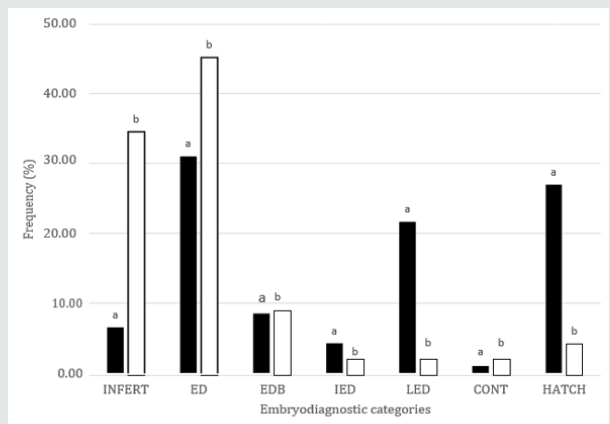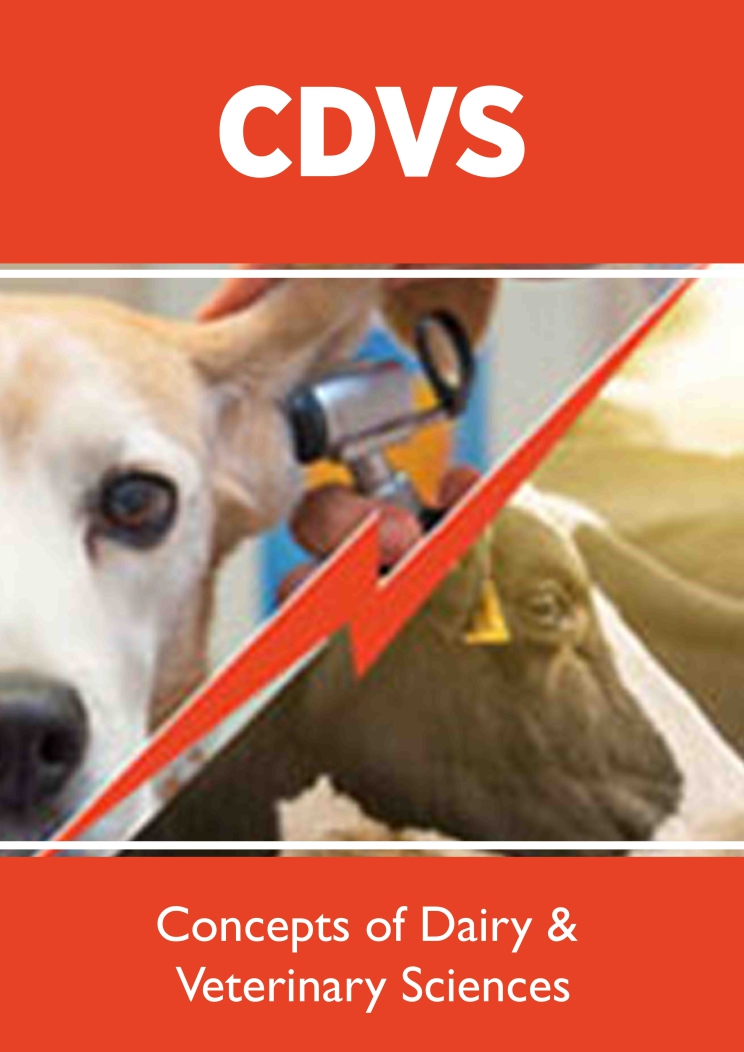
Lupine Publishers Group
Lupine Publishers
Menu
ISSN: 2637-4749
Research Article(ISSN: 2637-4749) 
Effect of Nicarbazin on Incubation Variables of Eggs from Creole Hens of Mexico Volume 3 - Issue 2
Pro-Martínez A1, Cuca-García JM1, Matus-Aragón MA1, Zárate-Contreras D1, Sosa-Montes E2, Osio-Orihuela L2, Reyes-Bello JG2 and González-Cerón F2*
- 1Postgraduate in Livestock, Montecillo Campus Graduate College, Mexico
- 2Department of Zootechnics, Chapingo Autonomous University, Mexico
Received: November 04, 2019; Published: December 18, 2019
Corresponding author: González-Cerón, Department of Zootechnics, Chapingo Autonomous University, Mexico
DOI: 10.32474/CDVS.2019.03.000158
Introduction
Nicarbazin (NCZ) is an equimolar complex of 4,4’-dinitrocarbanilide and 2-hydroxy-4,6-dimethylpyrimidine [1]. It is an anticoccidial agent used in the poultry industry. Its main function is to prevent multiplication and proliferation of parasites of Eimeria genus in the intestinal tract, avoiding tissue damage, decreased feed consumption, reduced nutrient absorption, dehydration, blood loss, skin depigmentation and susceptibility to other pathogens in birds [2]. Nevertheless, its application has not been entirely beneficial. Ott et al. [1] reported that feeding laying hens with 100 ppm or more of NCZ caused depigmentation of the brown shell and reduced hatchability in approximately 60%. Although the mode of action of NCZ for contraceptive activity is unknown, micrographs of vitelline membranes in mallards showed severe degenerative changes and preliminary in vitro studies indicated that it may increase intracellular calcium levels and early degradation of very low-density lipoproteins that comprise egg yolk [3]. However, the effect of NCZ has not been studied in Creole hens of Mexico. Therefore, the objective of this investigation was to evaluate the effect of NCZ on incubation variables of eggs from that genotype of birds.
Materials and Methods
This study was conducted at the Poultry Experimental Farm of the Chapingo Autonomous University at Texcoco, State of Mexico, Mexico. Located at an altitude of 2,247 m [4]. A total of 1922 eggs were collected from a population of 100 Creole hens of 80 weeks of age. Two treatments were evaluated: T2 (Control), 0.00% nicarbazin, and T1, 0.05% of nicarbazin in feed. Nine hundred and sixty-one eggs from the same population were used per treatment. The collection of eggs for T1 lasted 14 days, followed by a cleaning period of 21 days (feed without nicarbazin) and subsequently collecting eggs for T2. Storage was at an average temperature of 68 °F. The fertilization of the eggs was carried out by artificial insemination. Artificial incubation with a constant temperature of 100 °F and 60% relative humidity (RH) was used until day 18, then live embryos were passed to the hatcher (100 °F and RH: 80%). At 12 and 18 days of incubation eggs were candled to identify clear eggs and eggs with dead embryos, then the embryodiagnostic was carried out. Finally, at 21 days of incubation, non-hatched eggs were separated to conclude the embryodiagnostic. Early dead embryo with no blood (ED), 1-3 days of incubation; early dead embryo with blood (EDB), 4-12 days of incubation [5]; intermediate embryonic death (IED), 13-17 days of incubation; late embryonic death (LED) 18-21 days of incubation; infertile (INFERT); contaminated (CONT) and hatched eggs (HATCH) [6-8], were the categories considered in the embryodiagnostic. The feeding program consisted of a single phase with two diets, one containing 0.05% nicarbazin and one without nicarbazin, both diets containing 16% crude protein; 2,800 kcal ME kg-1 and 4% Ca Table 1. They were provided with a program of 16 light hours. Water was supplied for free access and feed was restricted to 110 g bird-1 day-1.
Table 1: 1/Provided per kg of diet: vitamin A, 12,000 IU; vitamin D3, 1,000 IU; vitamin E, 60 IU; vitamin K, 5.0 mg; vitamin B2, 8.0 mg; vitamin B12, 0.030 mg; pantothenic acid, 15 mg; niacin, 50 mg; folic acid, 1.5 mg; choline, 300 mg; biotin, 0.150 mg; thiamine, 3.0 mg. Fe, 50.0 mg; Zn, 110 mg; Mn, 100 mg; Cu, 12.0 mg; Se, 0.3 mg; I, 1.0 mg. 2Sand was used as an inert filler. Statistical analysis Frequency data of categories from embryodiagnostic were compared by the chi-square test for independence with the PROC FREQ contingency tests with α = 0.05, SAS Institute Inc. [12].

Results
Results of the embryodiagnostic can be observed at Figure 1. The values for the seven categories in the embryodiagnostic were different (P<0.05) between treatments. A higher proportion of the eggs were classified as infertile in T1 (34.5%) comparing to T2 (6.6%). Early embryo mortality (ED + EDB = 54.0%) was also higher in T1 with respect to T2 (ED + EDB = 39.5%), however, ED category contributed with most of the dead embryos in both treatments (45.2 and 31.0% for T1 and T2, respectively). IED category just contributed with a minor proportion of the embryo mortality in T1 (2.0%) and T2 (4.3). LED show a value of 2.8 and 21.6% for T1 and T2, respectively. Contaminated eggs represented 2.5% in T1 and 1.0% in T2. As a result of the values in the previous categories of the embryodiagnostic, hatchability values of 4.2 y 26.9% were obtained for T1 and T2, respectively.
Figure 1: Embryodiagnostic categories in eggs from Creole chicken breeders fed feed without (T2) or with nicarbazin (0.05%) (T1). INFERT: Infertile, ED: Early dead embryo with no blood, EDB: Early dead embryo with blood, IED: intermediate embryonic death, LED: late embryonic death, CONT: contaminated egg, and HATCH: hatched eggs.

Discussion
Even though there are previous reports of the negative effect of nicarbazin on incubation parameters of birds [9], there is not information with respect to birds that are not raised under industrial condition environments, as the Creole chickens of Mexico. Results of the current investigation agree with those of Hughes et al. [10] and Jones et al. [11] who found reduced hatchability in eggs from birds exposed to nicarbazin. As stated by Chapman et al. [12], affection of the integrity of the vitelline membrane is the mechanism by which the coccidiostat affects the correct development of the chick embryo, so that early mortality is expected. On the other hand, given what is known about its mechanism of action [3], the first stages of development are the most negatively affected by nicarbazin. In line with this fact, our results agree with Sherwood et al. [1] who found a 3.8-fold increase in early embryo mortality when White Rock breeder hens where fed nicarbazin. So that, embryos without blood spots or blood vessels (ED category in the current study) were the most abundant in the embryodiagnostic. As previously stated, Creole chickens of Mexico are raised under certain degree of harsh environmental conditions in terms of feed, housing, and potential pathogen agents [13,14], as coccidia. So that it was considered the necessity of evaluate the effect of a coccidiostat on incubation parameters of this poultry genotype. The results obtained indicate that nicarbazin should not be used in the feed of Creole breeder hens, given its negative effect on embryo mortality, specifically on the earliest stages of development [15].
Conclusion
Nicarbazin negatively affects the incubation variables, mainly in the early embryo mortality and hatchability, of Creole hens of Mexico.
Acknowledgements
Matus-Aragón, M.A. and Zárate-Contreras. D, thank to National Council of Science and Technology (CONACyT, Mexico) for the financial support for their graduate’s studies.
Conflict of Interest
The authors declare that there is not financial or conflict of interest in this contribution.
References
- Ott WH, Kuna S, Porter CC, Cuckler AC (1956) Biological studies on nicarbazin, a new anticoccidial agent. Poult Sci 35(6): 1355-1367.
- McDougald LR, Fitz Coy S (2013) Protozoal infections. In Diseases of Poultry (13thedn), Editor-in-Chief: David E. Swayne is Laboratory Director of the Southeast Poultry Research Laboratory, Agricultural Research Service, U.S. Department of Agriculture, in Athens, Georgia, USA, pp. 1147-1201.
- Yoder CA, Graham JK, Miller LA (2006) Molecular Effects of nicarbazin on avian reproduction. Poult Sci 85(7):1285-1293.
- Vázquez García JC, Pérez Padilla R (2000) Estimated gasometric values for the main populations and sites at higher altitude in Mexico. Rev Inst NalEnf Resp Mex 13(1): 6-13.
- Aviagen (2010) Reproductoresras-ROSS TECH investigation of incubation practices: fertility evaluation. Midlothian UK, p.48.
- Hamburger V, Hamilton H (1951) A series of normal stages in the development of the chick embryo. Dev Dyn 195(4): 231-272.
- Bellairs R, Osmond M (2014) Atlas of Chick Development. (3rdedn), Elsevier Academic Press, UK, pp. 692.
- Scott TA, Mackenzie CJ (1993) Incidence and classification of early embryonic mortality in broiler breeder chickens. Br Poult Sci 34(3): 459-470.
- Avery ML, Keacher KL, Tillman EA (2008) Nicarbazin bait reduces reproduction by pigeons (Columba livia). Wildlife Res 35(1): 80-85.
- Hughes BL, Jones JE, Toler JE, Solis J, Castaldo DJ (1991) Effects of exposing broiler breeders to nicarbazin contaminated feed. Poult Sci 70(3): 476-482.
- Jones JE, J Solis, BL Hughes, DJ Castaldo, Toler JE (1990) Reproduction responses of broiler-breeders to anticoccidial agents. Poult Sci 69(1): 27-36.
- Chapman DH (1994) A review of the biological activity of the anticoccidial drug nicarbazin and its application for the control of coccidiosis in poultry. Poult Sci Rev 5(4): 231-243.
- FlotaBañuelos C, Ramírez Mella M, Dorantes Jiménez J, José García G, Bautista Ortega J, et al. (2016) Descripción y diversidad de solaresfamiliaresen zonas rurales de Campeche, Mé Agroproductividad 9(9): 38-43.
- Mata-Estrada A (2018) Phenotypic characterization and productive behavior of backyard chickens in the state of Campeche, (PhD thesis in Sciences). Graduate School, Mexico, Mexico.
- SAS Institute Inc (2011) Base SAS®3 Procedures guide. Cary, NC, USA.

Top Editors
-

Mark E Smith
Bio chemistry
University of Texas Medical Branch, USA -

Lawrence A Presley
Department of Criminal Justice
Liberty University, USA -

Thomas W Miller
Department of Psychiatry
University of Kentucky, USA -

Gjumrakch Aliev
Department of Medicine
Gally International Biomedical Research & Consulting LLC, USA -

Christopher Bryant
Department of Urbanisation and Agricultural
Montreal university, USA -

Robert William Frare
Oral & Maxillofacial Pathology
New York University, USA -

Rudolph Modesto Navari
Gastroenterology and Hepatology
University of Alabama, UK -

Andrew Hague
Department of Medicine
Universities of Bradford, UK -

George Gregory Buttigieg
Maltese College of Obstetrics and Gynaecology, Europe -

Chen-Hsiung Yeh
Oncology
Circulogene Theranostics, England -
.png)
Emilio Bucio-Carrillo
Radiation Chemistry
National University of Mexico, USA -
.jpg)
Casey J Grenier
Analytical Chemistry
Wentworth Institute of Technology, USA -
Hany Atalah
Minimally Invasive Surgery
Mercer University school of Medicine, USA -

Abu-Hussein Muhamad
Pediatric Dentistry
University of Athens , Greece

The annual scholar awards from Lupine Publishers honor a selected number Read More...




